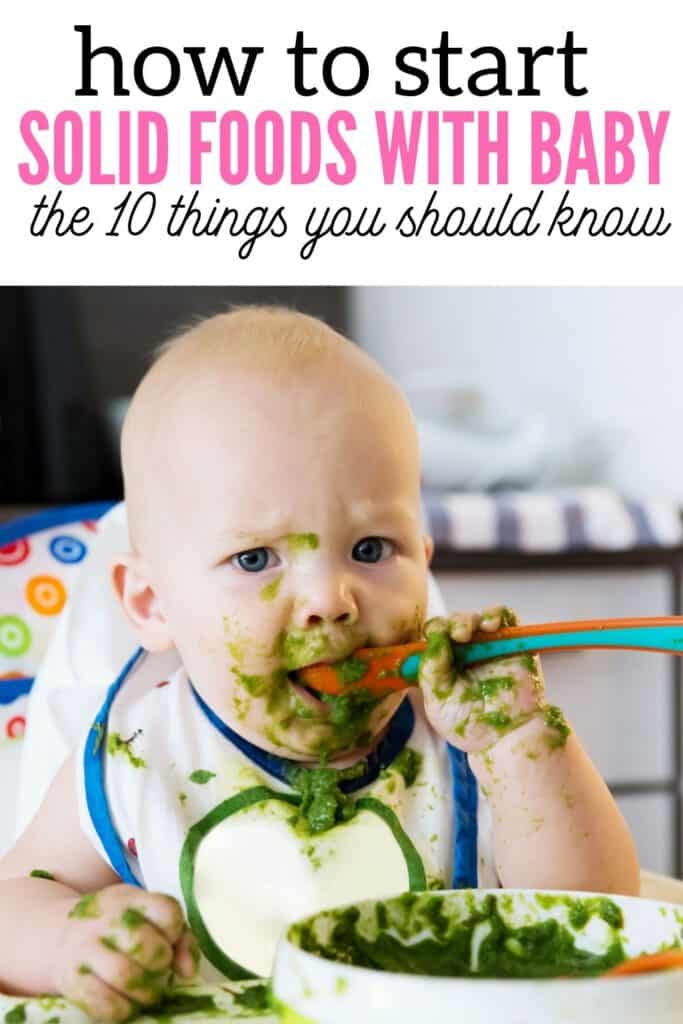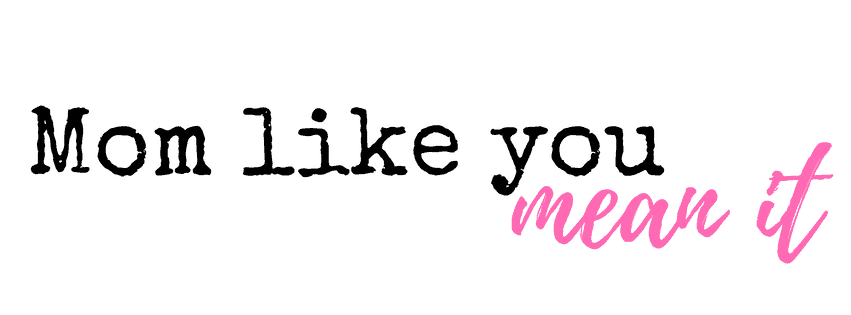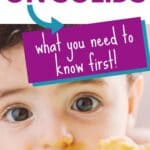If you ask your fellow mom friends when their babies started solids, you’ll likely get a lot of different answers, with most parents saying they started their baby on solids between 4 and 7 months.
But truthfully, rather than try to make sure your baby starts solids on the exact timetable their peers start, it’s best to talk with your doctor and take cues from your baby.
This post contains affiliate links. Read my policy here.
When to start baby on solids
Starting baby on solids can be an exciting, yet overwhelming time. For me, I had finally developed such a good breastfeeding routine that it was exhausting to think about introducing solids to Emma’s diet.
During our four month check up, the doctor mentioned that if I was ready, and Emma seemed ready, we could begin solids at 4 months. Even though the American Academy of Pediatrics recommends your baby can begin solids between 4 and 6 months, I’d always recommend checking with your baby’s pediatrician first.
Beyond getting the go ahead from your pediatrician, there are several cues you can take from baby to assess whether or not they’re ready for solids. Here’s some common signs your baby may be ready for solids:
- Baby sits up unassisted.
- Tongue thrust reflex is gone. Tongue thrust is the reflex that prevents infants from choking. (You’ll know this reflex is gone by testing the waters with solids– if your baby immediately pushes solid food out of his mouth, the reflex is still present).
- Baby is curious about what you are eating and may even try to steal some food from your plate.
How to start baby on solids
Once you’ve talked with your doctor and picked up on baby’s cues, it’s time to start some real food!
Many parents opt to start their baby out with a baby cereal (rice/oatmeal/barley), and then move on to fruits, veggies and pureed proteins.
Keep in mind, babies need iron at this age to grow and develop, so make sure foods containing iron (rice/barley/oat cereal, meat, poultry fish, lentils or beans all contain iron) are incorporated into their diet.
It’s not uncommon for your baby to dislike food at first. Remember, they’re used to just drinking formula or breastmilk at this point, so new smells, textures and consistencies can be difficult for them. Research shows that you may have to offer your baby a new food between 10-15 times before they’ll accept it. So don’t give up on a food in the first few tries!
In my personal experience, Emma hated solids! When I first introduced solids and she hated them, everything I read said to back off for a week or two, because sometimes babies aren’t quite ready when you are.
Introduce one new food to your baby every 3 to 4 days. Doing this will help you to easily pinpoint any food allergies your baby may have.
Keep in mind, babies will typically only eat one to two ounces of real food in one sitting. Don’t force baby or worry if they’re getting enough. Food is really just for practice at this point. Your baby will also do a great job of telling you she’s full. If you see her turning her head, swatting at the spoon or attempting to get out of the high chair, you can assume she’s done.
Should I feed solids before or after breastmilk or formula?
It’s important to remember that babies will receive the overwhelming majority of their nutritional needs from breastmilk or formula during their first year of life. Solids should not replace breastmilk or formula.
When you first introduce solids, your baby will only eat a very small amount, only eating solids once a day and slowly building to two to three meals per day by the time they are 8 or 9 months.
Breastfeed or give a bottle to your baby before you offer solids. Most articles I researched said it was best to wait about an hour after nursing/bottle to offer solids, and doing so really worked well for us, too.
Remember, you want baby to experience new tastes and textures, but you don’t want solids replacing formula or breastmilk at this point.
Common first foods
The most common first food many parents opt to start with is baby cereal. I opted to skip baby cereal at first and start with bananas just because I was eager to see her eat “real” food. When bananas didn’t work, (Emma still hates bananas to this day!) I moved back to baby cereal and mixed my pumped breast milk with that. She seemed to tolerate that okay.
Currently, there’s no scientific evidence as to whether or not you should start with veggies or fruits, although I have heard many of my friends say their doctor just recommended they try veggies first. Mine didn’t say it mattered one way or another.
Here’s a list of common first foods you can try with your baby. Just remember, if you aren’t trying the baby led weaning approach, (more on that below) all foods should be mashed with a fork or finely pureed before serving.
- Baby cereal (oat, wheat, or barley)
- Bananas
- Avocados
- Sweet Potatoes
- Pears
- Apple
- Carrots
- Butternut squash
- Blueberries
- Peaches
- Broccoli
- Chicken
- Beef
Remember to introduce a new food every three to four days to rule out any food allergies. Once you’ve introduced a couple foods you can always try mixing a couple together. My baby really liked the taste of rice cereal, so I frequently mixed that with fruits or veggies and that seemed to work well for her.
Want to make your own baby food? Read my complete guide on making your own baby food!
Baby led weaning
A baby led weaning approach completely skips over purees and feeding with a spoon, and instead allows babies to learn to feed themselves.
Experts recommend waiting until at least six months of age to begin a baby led weaning approach. In addition to typical cues your baby will give off to indicate they’re ready for solids, you’ll want to make sure that your baby has developed the motor skills to be able to pick up food, too.
There are many positives to baby led weaning: You get to skip out on making or buying purees, the baby learns to feed themselves at an early age, and develops good eating habits, just to name a few.
To get started with baby led weaning offer your baby soft foods that are easy for your baby to chew or gum. Here are some common first foods with the baby led weaning approach:
- Bananas
- Avocados
- Steamed carrots
- Cooked apples
- Melon
- Ripe peaches
- Slices of whole wheat bread
- Cooked noodles
Baby led weaning was something I tried after a month of introducing purees to Emma with very little success. Overall, she really enjoyed baby led weaning and it seemed to suit her personality better. If your baby seems totally uninterested in purees and you weren’t previously considering baby led weaning, I highly recommend it!
Foods to avoid
Foods need to be soft and easy for baby to digest when you’re just getting started. Beyond that, you need to avoid cow’s milk until your doctor gives you the go ahead at or around the one year mark.
Don’t give your baby honey, as there is the concern of infant botulism. And while we’re on the subject of sweeteners, it’s best to stay away from any added sugar.
Babies also have trouble processing added salt, so don’t offer any processed foods or meats.
Does my baby need water?
Before six months, research shows babies don’t need water as they get all the water the water they need from breastmilk or formula. Many parents start to wonder about offering water as they introduce solids, though.
After doing some research and talking with my pediatrician, I offered Emma water in a sippy cup (which really helped her learn to drink from a straw and hold her own cup) during meals. I didn’t exceed about 2 to 4 ounces of water per day.
How much breastmilk/formula should my baby consume when starting solids?
While you’re introducing foods to your baby, solids should not take the place of breastmilk or formula. (source)
After doing more research and talking with my pediatrician, I learned that feeding Emma solids about an hour after her last nursing/bottle session was best.
I continued to feed on demand, and over time, as she got closer to one year, she gradually dropped the amount of ounces she would eat/time she’d spend nursing. Take cues from your baby and don’t force a feeding or bottle.
Introducing allergenic foods to baby
It used to be the thought that delaying common allergy-inducing foods needed to be avoided until later in life to decrease the risk of developing an allergy. Now, thanks to new research from the LEAP study and the EAT study we know that to be the opposite.
Research shows that introducing common allergens like peanuts, fish and egg, as early as 6 months helps to reduce the chances your child might develop an allergy.
The American Academy of Allergy Asthma and Immunology does recommend that if you have a history of food allergies in your family that you consult with your doctor before giving your baby any known allergens.
To introduce peanut butter to Emma, I toasted some whole wheat bread and spread a very thin layer of peanut butter on it. At about 7 months I started making Emma eggs and she loved them. I had a harder time figuring out how to introduce fish, until I came across this brilliant article explaining to puree salmon with olive oil and some seasonings and then spread lightly on toast.
What if my baby refuses solids?
Emma hated just about everything I put in front of her for months. She’d turn her head away or bat at the spoon or cry. It was awful and so frustrating. And along the way I asked for help and did a ton of research on why she was refusing solids and what to do about. Here’s what I learned, in a nutshell.
Your baby might not be ready.
I waited until 6 months to introduce solids to Emma. During the first several introductions to food, Emma appeared to spit the food back out with her tounge immediately. I recognized this to mean her tongue thrust reflex wasn’t quite gone. If you observe this with your baby, I’d wait a week or two and try again.
After waiting a couple weeks, Emma did seem to take solids better but she hated them. She’d take one bite and then refuse to open her mouth again. At this point, on the recommendation of my doctor, I just kept trying. When she reached seven months and still didn’t like the idea of solids, I tried something else.
Your baby might not like baby food.
Some babies love purees, some really like the baby led weaning approach. After a month of hating purees, I started looking into baby led weaning for Emma. Emma seemed to really enjoy this process much better, but still took about a month and a half to warm up to eating a decent amount of solids.
Your baby might have a hard time grasping the food.
If your baby’s pincer reflex isn’t fully developed yet, and you’ve cut food into teeny tiny pieces, your baby might want to eat but feel frustrated that they can’t pick up anything! Once we moved to a baby led weaning approach and started offering soft fruits and cooked veggies in pieces that were small, yet manageable for her to pick up, Emma enjoyed eating much better.
Your baby might be full.
It’s best to space out a bottle or nursing session and “real food” time by at least an hour before so that baby doesn’t come to the table too full.
Your baby might be tired/upset/need a diaper change.
Sometimes I felt like finding the perfect window where she was in a good mood, not tired, not too full and had a clean diaper was a little bit like finding a needle in a haystack. To make sure your baby has the best experience possible, try to not stick to a strict schedule, as every day might look a little different. Instead, take cues from your baby. Look to feed her while she’s happy, not too tired and not too full, and you should have a better experience.
Above all else, just keep trying. Overall, it took about 2.5 months for Emma to decide she liked solids, and during that time I just kept trying. Eventually, it seemed like one day she just woke up and decided she liked eating! It can be a frustrating journey, but if you keep at it, your baby will likely come around.
Related articles on baby food:
How to make your own baby food
What to feed a one year old: 55 meal ideas


